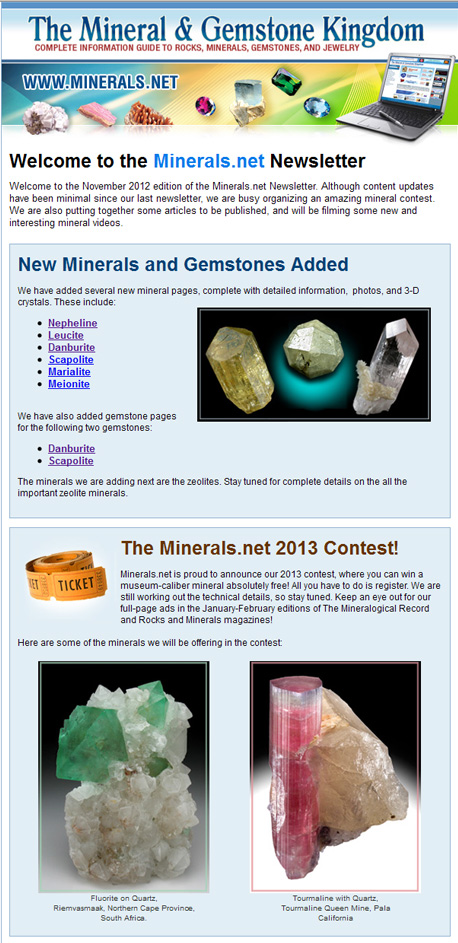Hurricane Sandy put us very behind in updates. We were without power for about a week, and this really threw us off. Now that we are finally recovered and back in business, we will continue with our updates. We started the zeolite minerals, and added the following new minerals complete with detailed information and pictures:
Stay tuned for more zeolites.
When observing the amazing minerals displayed in museums and collections, we marvel at their unique habits such as color, luster, and crystal shape. However, when these minerals are originally found, they don’t quite look like that. They are muddy, rough, and overall unattractive. It takes proper cleaning, trimming, and preparation to make a rough mineral into a beautiful display specimen.
In this article, I’ll discuss my method of cleaning and preparing my own specimens to make them display-worthy. When I come home from field collecting, I line my finds on my driveway and hose them with an outdoor garden hose. Small or fragile pieces are saved from this process to protect them. Once hosed and cleared of heavy mud and dirt, I take the specimens and either spray them with a high-pressure cleaning gun, or scrub them with an electric toothbrush head. (I don’t throw out old toothbrush heads – I use them to clean my minerals.)
Some minerals are soluble or sensitive to water, and therefore cannot be washed. Minerals such as the micas will absorb water and start flaking, and minerals such as Halite will dissolve. Though the vast majority of minerals are resistant to water, it is important to know which ones are not so that no damage will occur during washing.
Some minerals require more extensive cleaning, which water alone will not accomplish. For example, sometimes there is an ugly brown layer of iron oxides coating a specimen, or there could be an undesirable coating of Calcite. For iron oxides, I soak the mineral in Super Iron Out for a day or two, and for Calcite removal I soak the mineral in Lime Out (an easily available strong acid), which burns off the Calcite after a few days. Some minerals will get destroyed when using such chemicals or solvents, so it is important to know which minerals can handle different cleaning procedures. Much of this is learned from experience and trial and error.
Once cleaned, I proceed to trimming. I often do some rough trimming prior to a good water scrubbing, but perform a more precise and careful trimming after cleaning. Basic trimming involves gently chiseling extra parts of unwanted matrix or damaged crystals, and more intense trimming requires more effort such as smashing parts of matrix with a sledgehammer to reveal and better expose crystals. A hammer can also be used to smooth any undesirable rough or jagged edges on the matrix. This job has to be done very precisely, as imperfect trimming can totally ruin a display specimen.
Orientation is very important. A specimen able to sit on its own is most desirable. If possible, the main part of the display specimen should be centered on the matrix. Sometimes a matrix needs to be sawed flat on its bottom to properly size and position it. Matrix specimens are more desirable than free-standing crystals, so it is important to try to preserve the matrix when trimming. Unfortunately, crystals have a nasty habit of popping out of their matrix during specimen preparation.
When trimming or preparing minerals, good specimens will sometimes break in the process, though skillful preparation can usually prevent this. Fragile specimens may also break during handling. Occasionally, a specimen breaks with a clean fracture that can be easily repaired by gluing the two pieces together. This is especially true of a complete crystal that smoothly pops out of its matrix. A good repair job can make the specimen look almost as good as original, and a bad repair job can leave spaces in the contact area or glue stains.
A repair in a mineral will reduce its value. Poorly repaired minerals will have a highly reduced value. Though naturalists are against repairing minerals, most collectors are okay with the process as long as this is clearly disclosed when the mineral is purchased. For a dealer to sell a mineral that has been repaired, without having it clearly labeled as repaired is devious and dishonest.
We have blasted our summer edition of the Minerals.net online newsletter.
Click to view the email newsletter!

This snapshot is only part of the newsletter. Click the snapshot above to read the rest of it. We will also include the article "Mineral Specimen Preparation And Repairs" as a seperate article (see the next blog post.)
We have added new pages for the following Scapolite minerals:
We have also added a new gemstone page for the gemstone Scapolite.
We strive to present our visitors with up-to-date information. New mines and deposits are constantly being discovered, and many existing mines have recently become specimen producers. This is especially true in developing coutries such as China. In order to add in these new localities to our mineral data pages, we regularly visit mineral shows and speak to dealers to find out what's new and which localities should be added. We also read and research the popular mineral magazines and publications such as the Mineralogical Record and Rocks and Minerals.